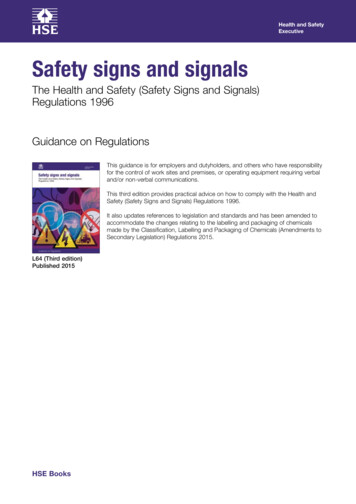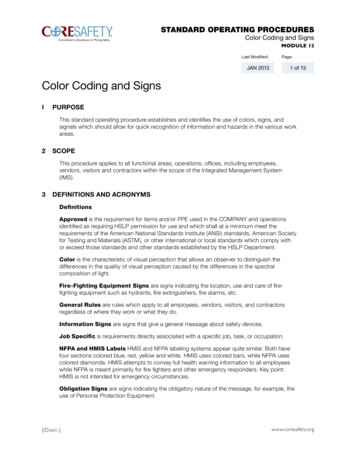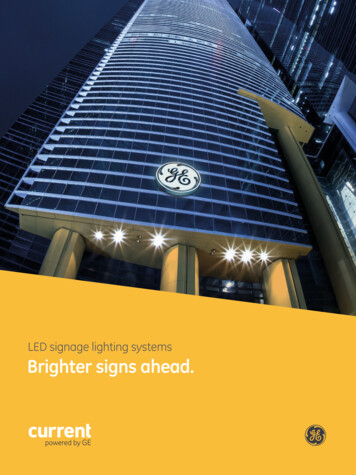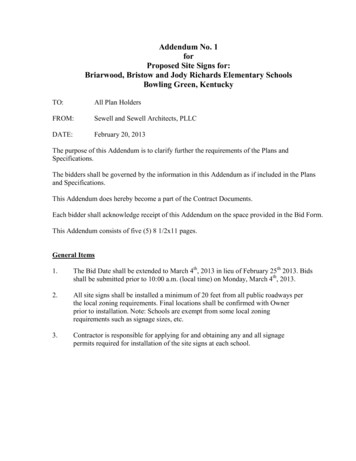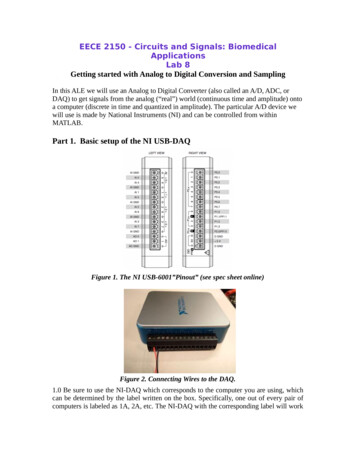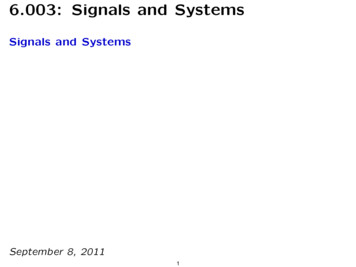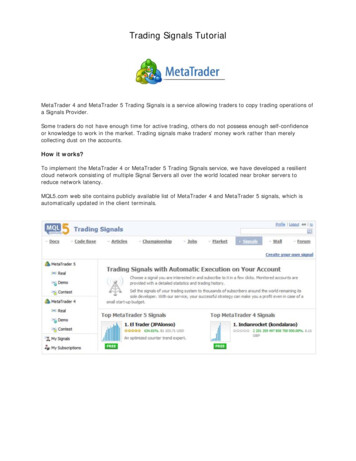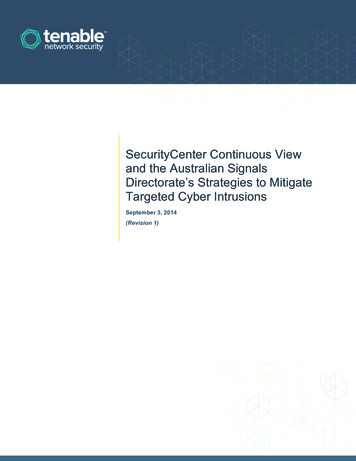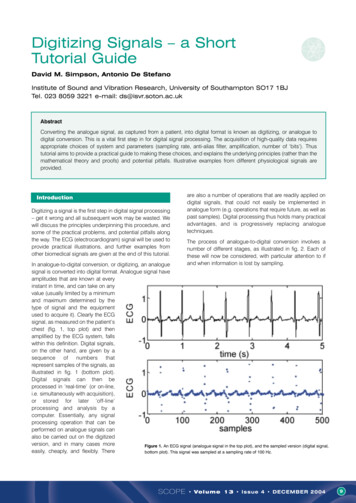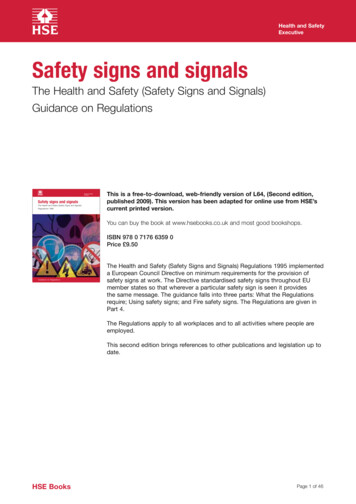
Transcription
Health and SafetyExecutiveSafety signs and signalsThe Health and Safety (Safety Signs and Signals)Guidance on RegulationsHealth and SafetyExecutiveSafety signs and signalsThe Health and Safety (Safety Signs and Signals)Regulations 1996This is a free-to-download, web-friendly version of L64, (Second edition,published 2009). This version has been adapted for online use from HSE’scurrent printed version.You can buy the book at www.hsebooks.co.uk and most good bookshops.ISBN 978 0 7176 6359 0Price 9.50Guidance on Regulations;OL /LHS[O HUK :HML[ :HML[ :PNUZ HUK :PNUHSZ 9LN\SH[PVUZ PTWSLTLU[LK H ,\YVWLHU *V\UJPS PYLJ[P]L VU TPUPT\T YLX\PYLTLU[Z MVY [OL WYV]PZPVU VM ZHML[ ZPNUZ H[ VYR ;OL PYLJ[P]L Z[HUKHYKPZLK ZHML[ ZPNUZ [OYV\NOV\[ , TLTILY Z[H[LZ ZV [OH[ OLYL]LY H WHY[PJ\SHY ZHML[ ZPNU PZ ZLLU P[ WYV]PKLZ [OL ZHTL TLZZHNL ;OL N\PKHUJL MHSSZ PU[V [OYLL WHY[Z! OH[ [OL 9LN\SH[PVUZ YLX\PYL" ZPUN ZHML[ ZPNUZ" HUK -PYL ZHML[ ZPNUZ ;OL 9LN\SH[PVUZ HYL NP]LU PU 7HY[ ;OL 9LN\SH[PVUZ HWWS [V HSS VYRWSHJLZ HUK [V HSS HJ[P]P[PLZ OLYL WLVWSL HYL LTWSV LK ;OPZ ZLJVUK LKP[PVU IYPUNZ YLMLYLUJLZ [V V[OLY W\ISPJH[PVUZ HUK SLNPZSH[PVU \W [V KH[L HSE BooksPage 1 of 46
Health and SafetyExecutive Crown copyright 2009First published 1996Second edition 2009ISBN 978 0 7176 6359 0All rights reserved. No part of this publication may be reproduced, stored ina retrieval system, or transmitted in any form or by any means (electronic,mechanical, photocopying, recording or otherwise) without the prior writtenpermission of the copyright owner.Applications for reproduction should be made in writing to:The Office of Public Sector Information, Information Policy Team,Kew, Richmond, Surrey TW9 4DU or e-mail: licensing@opsi.gov.ukFor use in - HSE GuidanceThis guidance is issued by the Health and Safety Executive. Following the guidanceis not compulsory and you are free to take other action. But if you do follow theguidance you will normally be doing enough to comply with the law. Health andsafety inspectors seek to secure compliance with the law and may refer to thisguidance as illustrating good practice.Page 2 of 46
Health and SafetyExecutiveContentsIntroduction 4Summary of Regulations 4Overall impact of Regulations – summary 4Fire safety 5PART 1 ABOUT THE REGULATIONS 6When did the Regulations come into force? 6What do the Regulations require? 6What about information, instruction and training? 6What is a safety sign? 7Where and to whom do these Regulations apply? 8PART 2 USING SAFETY SIGNS 10Using safety signs effectively 10Using signboards 11Signboards appearing in Schedule 1 12Using signs on containers and pipes 20Using signs to mark areas, rooms and enclosures 21Using signs to mark obstacles, dangerous locations and traffic routes 21Using acoustic signals and illuminated signs 22Using hand signals to direct hazardous operations 23Using verbal signals to direct hazardous operations 24Specific rules governing use 25PART 3 FIRE SAFETY SIGNS 25What is a fire safety sign? 25Using signs in buildings and structures 27Marking and identifying firefighting equipment 27Fire alarms 28Enforcing authority for fire safety 29Information, instruction and training 29PART 4 THE HEALTH AND SAFETY (SAFETY SIGNS AND SIGNALS)REGULATIONS 1996 29References 45Useful information 45Safety signs and signalsPage 3 of 46
Health and SafetyExecutiveIntroduction1The Health and Safety (Safety Signs and Signals) Regulations 1996 (the SafetySigns Regulations) implement European Council Directive 92/58/EEC on minimumrequirements for the provision of safety signs at work. This guidance is aimed athelping employers meet their responsibilities under these Regulations. The Directivestandardises safety signs throughout member states of the European Union sothat wherever a particular safety sign is seen it provides the same message. Theintention is that workers who move from site to site, such as service engineers,will not be faced with different signs at different workplaces. The Directive andthese Regulations require employers to provide safety signs where other methods,properly considered, cannot deal satisfactorily with the risks (see paragraph 11).They cover traditional safety signs, such as the well-known ‘no smoking sign’ andother means of communicating health and safety information, such as hand signals,acoustic signals (eg warning sirens on machines) and verbal communications. Afree leaflet Signpost to the Health and Safety (Safety Signs and Signals) Regulations1996,1 which is aimed at helping small businesses understand what is needed, isalso available.2This publication consists of guidance (Parts 1–3) and the Regulations (Part 4).The signs are reproduced in full colour in paragraph 42. Part 1 ‘What theRegulations require’ covers safety signs in general; Part 2 ‘Using safety signs’contains advice on their selection and use and explains the general requirementsfor the proper use of safety signs, including technical requirements (eg shape,colour etc) for different types of sign; Part 3 ‘Fire safety signs’ covers similar detailsfor fire safety signs.3The Regulations appear in Part 4, showing in one place much of the detail inthe European Directive (ie Annexes I–IX) now contained in the UK requirements (ieParts I–IX of Schedule 1 of the Safety Signs Regulations).Summary of Regulations4The Regulations require employers to use a safety sign where there is asignificant risk to health and safety that has not been avoided or controlled by themethods required under other relevant law, provided use of a sign can help reducethe risk. Safety signs are not a substitute for those other methods of controllingrisks such as engineering controls and safe systems of work.5They apply to all workplaces and to all activities where people are employed,but exclude signs used in connection with transport or the supply and marketing ofdangerous substances, products and equipment (see paragraph 21).6The Regulations require, where necessary, the use of road traffic signs inworkplaces to regulate road traffic (but see paragraph 22).Overall impact of Regulations – summary7Most firms already use safety signs to warn and instruct employees of risksto their health and safety. These Regulations are unlikely to impose any significantchanges in these cases because:(a) the bulk of the signboards are the same as those in BS 5378 Safety signs andcolours2 and BS 5499:2002 Graphical symbols and signs. Safety signs, includingfire safety signs.3 The signboards in the Regulations are included in paragraph 42 ofthis guidance;(b) the law already requires suitable illuminated signs and acoustic signals, eg fireSafety signs and signalsPage 4 of 46
Health and SafetyExecutive(c)(d)(e)alarms, to be used where necessary;although the Regulations contain a code of hand signals to assist mechanicalhandling and vehicle manoeuvring, other equivalent codes are acceptablesuch as BS 6736 Code of practice for hand signalling for use in agriculturaloperations4 and BS 7121-1:2006 Code of practice for safe use of cranes;5traffic routes and some dangerous locations (eg where people can slip, fallfrom heights, or there is low headroom) may need to be marked under theWorkplace (Health, Safety and Welfare) Regulations 1992 or the Work atHeight Regulations 2005. The Safety Signs Regulations specify the markingneeded and are consistent with BS 5378 and BS 5499;although these Regulations require stores and areas containing significantquantities of dangerous substances to be identified by appropriate warningsigns, they will mainly impact upon smaller stores. The majority of siteson which 25 tonnes or more of dangerous substances are stored can beexpected to be marked in accordance with the Dangerous Substances(Notification and Marking of Sites) Regulations 1990. These have similarmarking requirements for storage of most dangerous substances. Storescontaining very small quantities or where labels on containers can clearly beseen from outside need not be marked.Fire safety8These Regulations implement those parts of the Directive dealing with firesafety. Advice on the use of fire safety signs can be obtained from your enforcingauthority for fire safety (see paragraph 113). In general, these Regulations will notrequire any changes where existing fire safety signs containing symbols complywith BS 5499. New signs are also acceptable if they are similarly chosen to complywith BS 5499 (see paragraph 91).Safety signs and signalsPage 5 of 46
Health and SafetyExecutivePART 1 ABOUT THE REGULATIONSGuidanceWhen did the Regulations come into force?(regulation 1)9The Regulations and duties on employers in respect of safety signs came intoforce on 1 April 1996.What do the Regulations require? (regulation 4)10 The Regulations require employers to ensure that safety signs are provided(or are in place) and maintained in circumstances where risks to health and safetyhave not been avoided by other means, for example engineering controls or safesystems of work.11 In determining where to use safety signs, employers need to take into accountthe results of the risk assessment made under the Management of Health andSafety at Work Regulations 1999 (the Management Regulations). This assessmentdeals with hazard identification, the risks associated with those hazards, andthe control measures to be taken. When the control measures identified in theassessment have been taken there may be a ‘residual’ risk such that employeesneed to be warned, and informed of any further measures necessary. Safety signsare needed if they will help to reduce this residual risk. If the risk is not significantthere is no need to provide a sign.12 These Regulations make it clear that safety signs are not a substitute for othermeans of controlling risks to employees; safety signs are to warn of any remainingsignificant risk or to instruct employees of the measures they must take in relationto these risks. For example in some workplaces there may be a risk of foot injurydespite taking measures to control the risk. In this case it may be appropriate toremind staff with the sign indicating that wearing foot protection is mandatory.13 These Regulations do not require safety signs to be used where there areno significant risks to health and safety. Note, however, that certain fire safetysigns may be specified under quite separate legal provisions (eg maybe to complywith requirements in a fire certificate). If you have any doubts check this with yourenforcing authority for fire safety (see paragraph 113).What about information, instruction and training?(regulation 5)14 It may be appropriate for employers to explain to their employees thecircumstances in which some safety signs are needed, and then check that theiremployees are aware of and understand the meaning of those signs they comeinto contact with during their work.15 Research indicates that not all safety signs are well understood. It is thereforeimportant that employers explain to their employees what action they will betaking to meet the requirements of these Regulations and ensure that employeesare aware of and understand the meaning of safety signs and signals eitherseen or heard during their work. Although most safety signs are self-explanatory,employees (particularly new ones) may be unfamiliar with the meaning of someof the less commonly used signs. It is therefore important that the meaning ofSafety signs and signalsPage 6 of 46
Health and SafetyExecutiveGuidanceany unfamiliar sign is clearly explained, and that employees are aware of theconsequences of not following the warning or instruction given by the sign. Textsupplementing the sign may have a useful role here (see paragraph 40).What is a safety sign? (regulation 2)16 The Regulations cover a variety of methods of communicating health andsafety information in addition to the traditional safety sign or signboard. The termsused in the Regulations mean the following:(a)(b)safety and/or health sign – a sign providing information or instruction aboutsafety or health at work by means of a signboard, a colour, an illuminated signor acoustic signal, a verbal communication or hand signal;signboard – a sign which provides information or instructions by acombination of shape, colour and a symbol or pictogram which is renderedvisible by lighting of sufficient intensity. In practice many signboards may beaccompanied by supplementary text (eg ‘Fire exit’ alongside the symbol of amoving person – see also paragraph 40). Signboards can be of the followingtypes:(i)prohibition sign – a sign prohibitingbehaviour likely to increase or cause danger (eg ‘noaccess for unauthorised persons’);(ii)warning sign – a sign giving warning of ahazard or danger (eg ‘danger: electricity’);(iii)mandatory sign – a sign prescribing specificbehaviour (eg ‘eye protection must be worn’);(iv)emergency escape or first-aid sign – asign giving information on emergency exits, firstaid, or rescue facilities (eg ‘emergency exit/escaperoute’. Note: signs complying with BS 5499 are alsoacceptable, see paragraph 91);Safety signs and signalsPage 7 of 46
Health and SafetyExecutive(c)Guidance(d)(e)(f)(g)(h)(i)safety colour – a colour to which a specific meaning is assigned (eg yellowmeans ‘be careful’ or ‘take precautions’);symbol or pictogram – these appear in Schedule 1, although some variationin detail is acceptable provided the meaning is the same. They are for use ona signboard or illuminated sign (eg the trefoil ionising radiation warning sign);illuminated sign – a sign made of transparent or translucent materials whichis illuminated from the inside or the rear to give the appearance of a luminoussurface (eg many emergency exit signs);acoustic signal – a sound signal which is transmitted without the use of ahuman or artificial voice (eg fire alarm);verbal communication – a predetermined spoken message communicatedby a human or artificial voice;hand signal – a movement or position of the arms or han
colours2 and BS 5499:2002 Graphical symbols and signs. Safety signs, including fire safety signs.3 The signboards in the Regulations are included in paragraph 42
